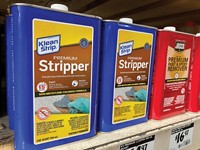Advertisement
Grab your lab coat. Let's get started
Welcome!
Welcome!
Create an account below to get 6 C&EN articles per month, receive newsletters and more - all free.
It seems this is your first time logging in online. Please enter the following information to continue.
As an ACS member you automatically get access to this site. All we need is few more details to create your reading experience.
Not you? Sign in with a different account.
Not you? Sign in with a different account.
ERROR 1
ERROR 1
ERROR 2
ERROR 2
ERROR 2
ERROR 2
ERROR 2
Password and Confirm password must match.
If you have an ACS member number, please enter it here so we can link this account to your membership. (optional)
ERROR 2
ACS values your privacy. By submitting your information, you are gaining access to C&EN and subscribing to our weekly newsletter. We use the information you provide to make your reading experience better, and we will never sell your data to third party members.
Chemical Regulation
EPA seeks limits on NMP use
Solvent would be banned in some applications and regulated in others
by Michael McCoy
June 12, 2024
| A version of this story appeared in
Volume 102, Issue 18

Continuing to take action on 10 potentially harmful chemicals it is evaluating under revisions to the Toxic Substances Control Act (TSCA), the US Environmental Protection Agency says it is seeking new limits on the use of the solvent N-methylpyrrolidone (NMP).
In a May 5 proposal, the agency says it wants to ban the use of NMP in auto care, cleaning and degreasing, metal, and cleaning and furniture-care products. The EPA proposes to limit NMP concentration to 45% in glues and adhesives. And it is proposing a workplace protection program to prevent direct skin contact with NMP in industries like semiconductor and lithium-ion battery manufacturing that continue to use the solvent.

“We’re making great strides in our efforts to protect people’s health from exposure to chemicals like NMP,” Michal Freedhoff, assistant administrator for the EPA’s Office of Chemical Safety and Pollution Prevention, says in a press release announcing the proposal. “Our proposed commonsense worker protections would keep people safe while also ensuring that NMP could continue to be used, as needed.”
NMP is 1 of the initial 10 chemicals the EPA targeted in 2016 for potential limitations on use. It later added 20 more chemicals to the list. In April, the EPA finalized a ban on most uses of 1 of the 10, the solvent methylene chloride. And in March, it banned chrysotile asbestos, the last type of asbestos still used in the US, mainly in diaphragms found in plants that make chlorine and caustic soda.
Unlike methylene chloride and asbestos, though, NMP is a necessary solvent in some industries, the EPA acknowledges. The agency says it expects that sectors like chip- and battery-making have already implemented exposure controls of the type that it would require. In other industries, including paints, adhesives, and inks, the EPA proposes controls such as concentration limits and the use of personal protective equipment.
In 2020 the agency concluded that NMP-based paint strippers are not a risk to consumers, and indeed, the proposed rule doesn’t contain limits on such products. The solvent was once touted as a safer alternative to methylene chloride in paint strippers, but major retailers like Home Depot, Lowe’s, and Walmart dropped both kinds of strippers several years ago.





Join the conversation
Contact the reporter
Submit a Letter to the Editor for publication
Engage with us on Twitter